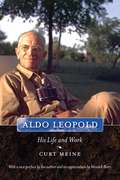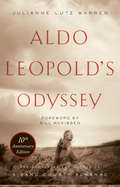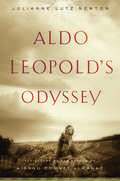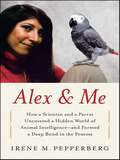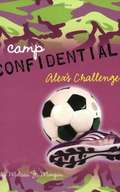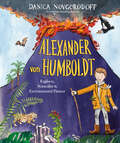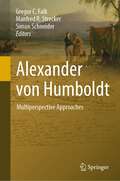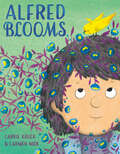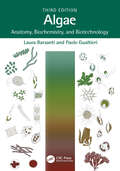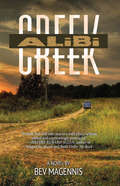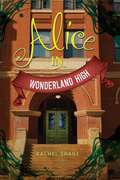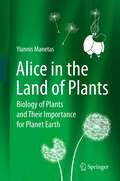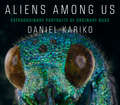- Table View
- List View
Aldo Leopold
by Curt MeineThis biography of Aldo Leopold follows him from his childhood as a precocious naturalist to his profoundly influential role in the development of conservation and modern environmentalism in the United States. This edition includes a new preface by author Curt Meine and an appreciation by acclaimed Kentucky writer and farmer Wendell Berry.
Aldo Leopold's Odyssey, Tenth Anniversary Edition: Rediscovering the Author of A Sand County Almanac
by Julianne Lutz WarrenIn 2006, Julianne Lutz Warren(néeNewton) asked readers to rediscover one of history's most renowned conservationists. Aldo Leopold's Odyssey was hailed by The New York Times as a "biography of ideas," making "us feel the loss of what might have followed A Sand County Almanac by showing us in authoritative detail what led up to it. " Warren's astute narrative quickly became an essential part of the Leopold canon, introducing new readers to the father of wildlife ecology and offering a fresh perspective to even the most seasoned scholars. A decade later, as our very concept of wilderness is changing, Warren frames Leopold's work in the context of the Anthropocene. With a new preface and foreword by Bill McKibben, the book underscores the ever-growing importance of Leopold's ideas in an increasingly human-dominated landscape. Drawing on unpublished archives, Warren traces Leopold's quest to define and preserve land health. Leopold's journey took him from Iowa to Yale to the Southwest to Wisconsin, with fascinating stops along the way to probe the causes of early land settlement failures, contribute to the emerging science of ecology, and craft a new vision for land use. Leopold's life was dedicated to one fundamental dilemma: how can people live prosperously on the land and keep it healthy, too? For anyone compelled by this question, the Tenth Anniversary Edition of Aldo Leopold's Odyssey offers insight and inspiration.
Aldo Leopold's Odyssey: Rediscovering the Author of A Sand County Almanac
by Julianne Lutz NewtonA household icon of the environmental movement, Aldo Leopold (1887-1948) may be the most quoted conservationist in history. A Sand County Almanac has sold millions of copies and Leopold's writings are venerated for their perceptions about land and how people might live in concert with the whole community of life. But who is the man behind the words? How did he arrive at his profound and poetic insights, inspiring generations of environmentalists? Building on past scholarship and a fresh study of Leopold's unpublished archival materials, Julianne Lutz Newton retraces the intellectual journey generated by such passion and intelligence. Aldo Leopold's Odyssey illuminates his lifelong quest for answers to a fundamental issue: how can people live prosperously on the land and keep it healthy, too? Leopold's journey took him from Iowa to Yale to the Southwest to Wisconsin, with fascinating stops along the way to probe the causes of early land settlement failures, contribute to the emerging science of ecology, and craft a new vision for land use. More than a biography, this articulate volume is a guide to one man's intellectual growth, and an inspirational resource for anyone pondering the relationships between people and the land.
Aldo Leopold: A Sand County Almanac & Other Writings on Conservation and Ecology
by Aldo Leopold Curt MeineSince his death in 1948, Aldo Leopold has been increasingly recognized as one of the indispensable figures of American environmentalism. A pioneering forester, sportsman, wildlife manager, and ecologist, he was also a gifted writer whose farsighted land ethic is proving increasingly relevant in our own time. Now, Leopold's essential contributions to our literature--some hard-to-find or previously unpublished--are gathered in a single volume for the first time. Here is his classic A Sand County Almanac, hailed--with Thoreau's Walden and Carson's Silent Spring--as one of the main literary influences on the modern environmental movement. Published in 1949, it is still astonishing today: a vivid, firsthand, philosophical tour de force. Along with Sand County are more than fifty articles, essays, and lectures exploring the new complexities of ecological science and what we would now call environmental ethics. Leopold's sharp-eyed, often humorous journals are illustrated here for the first time with his original photographs, drawings, and maps. Also unique to this collection is a selection of over 100 letters, most of them never before published, tracing his personal and professional evolution and his efforts to foster in others the love and sense of responsibility he felt for the land.
Alebrijes: (Alebrijes Spanish Edition) (Cuentista)
by Donna Barba HigueraLa siguiente novela de Donna Barba Higuera, autora de The Last Cuentista (La última cuentista), galardonada con los premios Newbery y Pura Belpré ★ "Un clásico inmediato".—School Library Journal (destacado) ★ "Imaginación esplendorosa".—Foreword (destacado)★ "Un texto muy sentido que da señales de esperanza para la humanidad".—Kirkus (destacado)★ "Una aventura arriesgada… Asombrosa".—Booklist (destacado)★ "Estelar".—Publishers Weekly (destacado)★ "Inspiradora".—Bulletin of the Center for Children’s Books (destacado) ★ "Impresionante... Una novela distópica para jóvenes lectores que es intensamente épica y bella".—Shelf Awareness (destacado) He aquí la historia, tal como me la contó Leandro el Poderoso. Desde hace 400 años, la Tierra es un páramo estéril. Los pocos humanos que quedan luchan por sobrevivir en la cruel ciudad de Pocatel. Su otra opción es aventurarse solos en las tierras salvajes, que están plagadas de espíritus errantes y gudrones. No duran mucho.Leandro, un ladroncito de 13 años, y su hermana Gabi hacen lo que pueden para forjarse una vida en Pocatel. La ciudad no es amable con cascabeles como ellos, descendientes de quienes trabajaron en el valle de San Joaquín durante generaciones.Luego de que atrapan a Gabi robando la preciada fruta de la elite pocatelana, Leandro asume la responsabilidad del robo. Su exilio resulta ser mucho más de lo que él podría haber imaginado de un simple destierro: su conciencia es colocada en un antiguo dron y... a arreglárselas solo. Pero más allá de los muros de Pocatel hay otros alebrijes que, como Leandro, quieren un mundo mejor. También hay monstruos mutantes, piratas del páramo, un oasis oculto... y la verdad.Escrita por Donna Barba Higuera, autora de The Last Cuentista (La última cuentista), libro premiado con la Medalla Newbery y el premio Pura Belpré, llega esta nueva novela para sorprendernos y crear un nuevo mundo lleno de imaginación, espejo del nuestro.***The next stunning novel from Donna Barba Higuera, author of Newbery and Pura Belpré Award-winning The Last Cuentista ★ "An instant classic."—School Library Journal (starred) ★ "Imaginative splendor."— Foreword (starred) ★"Heartfelt… Signals hope for humanity."— Kirkus (starred) ★ "High-stakes adventure…Wondrous."— Booklist (starred) ★ "Stellar."— Publishers Weekly (starred) ★ "Uplifting."— Bulletin of the Center for Children’s Books (starred) ★ "Breathtaking... A ferociously epic and beautiful middle-grade dystopian novel."— Shelf Awareness (starred) This is the story as it was told to me by Leandro the Mighty. For 400 years, Earth has been a barren wasteland. The few humans that survive scrape together an existence in the cruel city of Pocatel – or go it alone in the wilderness beyond, filled with wandering spirits and wyrms. They don’t last long.13 year-old pickpocket Leandro and his sister Gabi do what they can to forge a life in Pocatel. The city does not take kindly to Cascabel like them – the descendants of those who worked the San Joaquin Valley for generations.When Gabi is caught stealing precious fruit from the Pocatelan elite, Leando takes the fall. But his exile proves more than he ever could have imagined -- far from a simple banishment, his consciousness is placed inside an ancient drone and left to fend on its own. But beyond the walls of Pocatel lie other alebrijes like Leandro who seek for a better world -- as well as mutant monsters, wasteland pirates, a hidden oasis, and the truth.From Donna Barba Higuera, Newbery and Pura Belpré Medal-winning author of The Last Cuentista, comes another novel to astonish us and create a whole new imaginative world, that holds a mirror to our own.
Alex & Me: How a Scientist and a Parrot Discovered a Hidden World of Animal Intelligence—and Formed a Deep Bond in the Process
by Irene M. PepperbergNew York Times BestsellerThe remarkable true story of an extraordinary relationship between psychologist Irene M. Pepperberg and Alex, an African Grey parrot who proved scientists and accepted wisdom wrong by demonstrating an astonishing ability to communicate and understand complex ideas. "You be good. I love you," were Alex's final words to his owner, research scientist Irene Pepperberg, before his premature death at age thirty-one on September 6, 2007. An African Grey parrot, Alex had a brain the size of a shelled walnut, yet he could add, sound out words, understand concepts like bigger, smaller, more, fewer, and none, and he disproved the widely accepted idea that birds possess no potential for language or anything remotely comparable to human intelligence.Alex & Me is the incredible story of an amazing, irascible parrot and his best friend who stayed together through thick and thin for thirty years—the astonishing, moving, and unforgettable story of a landmark scientific achievement and a beautiful relationship.
Alex's Challenge (Camp Confidential #4)
by Melissa J. MorganDuring the last weeks of summer camp, eleven-year-old Alex Kim has trouble hiding a secret from the other girls in bunk 3C while also trying to meet the high standards she sets for herself in sports, relationships, and other activities.
Alexander Wilson: The Scot Who Founded American Ornithology
by Edward H. Burtt William E. Davis Jr.Audubon was not the father of American ornithology. That honorific belongs to Alexander Wilson, whose encyclopedic American Ornithology established a distinctive approach that emphasized the observation of live birds. In the first full-length study to reproduce all of Wilson's unpublished drawings for the nine-volume Ornithology, Edward Burtt and William Davis illustrate Wilson's pioneering and, today, underappreciated achievement as the first ornithologist to describe the birds of the North American wilderness. Abandoning early ambitions to become a poet in the mold of his countryman Robert Burns, Wilson emigrated from Scotland to settle near Philadelphia, where the botanist William Bartram encouraged his proclivity for art and natural history. Wilson traveled 12,000 miles on foot, on horseback, in a rowboat, and by stage and ship, establishing a network of observers along the way. He wrote hundreds of accounts of indigenous birds, discovered many new species, and sketched the behavior and ecology of each species he encountered. Drawing on their expertise in both science and art, Burtt and Davis show how Wilson defied eighteenth-century conventions of biological illustration by striving for realistic depiction of birds in their native habitats. He drew them in poses meant to facilitate identification, making his work the model for modern field guides and an inspiration for Audubon, Spencer Fullerton Baird, and other naturalists who followed. On the bicentennial of his death, this beautifully illustrated volume is a fitting tribute to Alexander Wilson and his unique contributions to ornithology, ecology, and the study of animal behavior.
Alexander von Humboldt: Explorer, Naturalist & Environmental Pioneer
by Danica NovgorodoffBudding botanists, growing geologists, and early explorers will dive into this picture book biography about the father of ecology, Alexander von Humboldt. The captivating prose and art from a New York Times bestselling illustrator will spark a passion for discovery and conservation in the youngest readers.Whether sailing across the ocean, hiking through the jungle, or climbing the highest volcanic peaks, everywhere Alexander went, he observed the land, animals, and culture. And where others saw differences, Alexander spotted connections. Discover the incredible life of naturalist Alexander von Humboldt, whose explorations created the basis for modern ecology, whose travels made him one of the most famous scientists of his day, and whose curiosities have inspired generations of creative thinkers.
Alexander von Humboldt: Multiperspective Approaches
by Gregor C. Falk Manfred R. Strecker Simon SchneiderThis book aims to view and to understand Alexander von Humboldt from different perspectives and in varying disciplinary contexts. His contributions addressed numerous topics in the earth but also life sciences—spanning from geo-botany, climatology, paleontology, oceanography, mineralogy, resources, and hydrogeology to links between the environmental impact of humans, erosion, and climate change. From the very beginning, he paved the way for a modern, integrated earth system science approach to decipher, characterize, and model the different forcing factors and their feedback mechanisms. It becomes obvious that Humboldt’s holistic approach is far beyond simple description and empiric data collection. As documented and analyzed in the different texts of this volume, he combines observation and analysis with emotions and subjective perceptions in a very affectionate way. However, this publication does not intend to add another encyclopedic text compilation but to observe and critically analyze this unique personality´s relevance in a modern context, particularly in discussing environmental and social key issues in the twenty-first century.
Alfred Blooms
by Carrie KruckShy Alfred wants to befriend the girl whose yard is filled with other kids and flowers but he doesn't know how. When Alfred sees Lulu&’s magical yard filled with flowers and friends, he&’s sure that if he can cultivate a beautiful garden, friends will flock to join him. Alfred tries but nothing grows in his brown patch of dirt. Determined to make one last attempt, Alfred heads to the store to buy fresh flower seeds. As he hurries home, he sneezes—and the seeds fly everywhere! And this time they begin to grow wherever they land—in his pockets, in his hair, even in his ears! A very discouraged Alfred gets stuck in the mud. But the aroma of warm blueberry muffins coming from a nearby bakery reminds him of Lulu&’s favorite treat and, tucking the flowers under his hat, he heads there. Alfred shares muffins with Lulu and finds out that he doesn&’t need a garden; time spent together is the best way to make a friend. This charming friendship story is sensitive and delightful with just a touch of whimsy.
Algae: Anatomy, Biochemistry, and Biotechnology
by Laura Barsanti Paolo GualtieriA single-source reference on the biology of algae, the third edition of Algae: Anatomy, Biochemistry, and Biotechnology examines the most important taxa and structures for freshwater, marine, and terrestrial forms of algae. Its comprehensive coverage goes from algae's historical role through its taxonomy and ecology to its natural product possibilities. In this update, the authors have gathered a significant amount of new material, including: • more information on macroalgae • detailed description of biotic associations • updated description of biomass cultivation systems • coverage of different "omic" approaches and tools used in algal investigation • an expanded and updated algae utilization chapter The book's unifying theme is the important role of algae in the earth's self-regulating life support system and its function within restorative models of planetary health. It also discusses algae's biotechnological applications, including potential nutritional and pharmaceutical products. Written for students as well as researchers, teachers, and professionals in the field of phycology and applied phycology, this new full-color edition is both illuminating and inspiring.
Algal Biorefinery: Developments, Challenges and Opportunities (Routledge Studies in Bioenergy)
by Sonil Nanda Ajay K. Dalai Vaibhav V. Goud Venu Babu BorugaddaThis book enables readers to understand the theoretical aspects, key steps and scientific techniques with a detailed mechanism to produce biofuels from algae. Each chapter provides the latest developments and recent advancements starting from algal cultivation techniques to the production of value-added green fuels, chemicals and products with wide applications. The volume brings together a broad range of international and interdisciplinary experts, including chemical and biological engineers, biotechnologists, process engineers, environmentalists, pharmacists and nutritionists, to one platform to explore the beneficial aspects and challenges for an algal-based biorefinery. Chapters address cutting-edge issues surrounding algal cultivation, including genetic modification of algal strains, design and optimization of photobioreactors and open-pond systems, algal oil extraction techniques and algal-derived fuel products (biodiesel, bio-gasoline, jet fuels and bio-oil). Finally, the book considers the potential environmental impacts for establishing a sustainable algal biorefinery through lifecycle analysis, techno-economic assessment and supply chain management. This book will be an important resource for students, academics and professionals interested in algal cultivation, biofuels and agricultural engineering, and renewable energy and sustainable development more broadly.
Algonquin Wildlife: Lessons in Survival
by Norm Quinn Cassandra Ward Dan StricklandAlgonquin Wildlife: Lessons in Survival is a celebration of the vast array of wildlife studies ongoing in Ontario’s very first provincial park. Probably more research has been done in Algonquin than in any other protected landscape in the world. Norm Quinn, long-time Park Management Biologist in Algonquin, has been fortunate to know and to work with many of those dedicated and unique wildlife researchers who roam and probe the forests and lakes in search of Nature’s secrets. His knowledge, experience and sense of humour combine to transform technical biological studies, on moose, wolves, fish and other creatures of the wild, into entertaining and inviting stories without losing the significance of the research. This is also a book about Algonquin, Ontario’s flagship Park and one of the foremost canoe-tripping wilderness sites in the world. Through Algonquin Wildlife, you are invited to explore this relatively unknown but vital part of the Park’s heritage – a must for both seasoned and budding naturalists.
Algorithms for Next-Generation Sequencing (Chapman & Hall/CRC Computational Biology Series)
by Wing-Kin SungAdvances in sequencing technology have allowed scientists to study the human genome in greater depth and on a larger scale than ever before – as many as hundreds of millions of short reads in the course of a few days. But what are the best ways to deal with this flood of data? Algorithms for Next-Generation Sequencing is an invaluable tool for students and researchers in bioinformatics and computational biology, biologists seeking to process and manage the data generated by next-generation sequencing, and as a textbook or a self-study resource. In addition to offering an in-depth description of the algorithms for processing sequencing data, it also presents useful case studies describing the applications of this technology.
Alibi Creek
by Bev Magennis"[S]omething of a southwestern gothic, drawing inspiration from the spare depictions of the West in the novels of Annie Proulx and its familial drama from the likes of Faulkner, O'Connor, and their ilk...excels in its open-eyed portrayals of a land largely left untamed...carries a surprising amount of grit and poetic verve."-KIRKUS REVIEWS"A saga set in the wilds of New Mexico...Lee Ann is a heroine readers will root for."-PUBLISHERS WEEKLY"Magennis is a yarn spinner with a passion for the southwestern wilderness, the people who inhabit unlimited space, and drama created in a setting that allows for complete freedom. A book that will take you to a wild place, seldom visited and captivatingly portrayed."-JEFFERY RENARD ALLEN, author of Song of the Shank and Rails Under My Back"In Alibi Creek, Bev Magennis captures the grit and sinew of men and women raised in the hardscrabble West. The land produces both good and evil, and Magennis's characters as well as her story are as authentic as the sagebrush of the western landscape."-SANDRA DALLAS, New York Times bestselling author of True Sisters"...a novel about boundaries and belonging and facing up to when the old excuses no longer wash."-CHARLIE QUIMBY, author of Monument Road"This stunning debut transforms and arrests the reader, the story stays with you long after you turn the last page."-LIBBY FLORES, PEN Center USAFollowing a two-year prison stint, charming and wily Walker returns to his family's New Mexico ranch, where his pious older sister Lee Ann is busy caring for their mother, raising two sons, and grappling with unethical workplace demands. Walker's illegal activities quickly incite chaos in the town and Lee Ann's marriage, leading to drastic transformations of beliefs, identities, and relationships.Bev Magennis was born in Toronto, Ontario, and immigrated to the US in 1964. She received her MA in Art from the Claremont Graduate School, Claremont, California. After a thirty-five-year career as an artist, she started writing, inspired by the land and people in the New Mexico wilderness where she lived for seventeen years. In 2009 she was accepted to the Iowa Writers' Workshop Summer Graduate Class and in 2010 was awarded an eight-month Pen USA Emerging Voices Fellowship. In 2011 she received a Norman Mailer Writers Colony Fiction Fellowship. She lives in Albuquerque, New Mexico.
Alice In Wonderland High
by Rachel ShaneWill this Mad Tea Party put Alice in hot water?Alice is rebellion-ready, eager to save the world and come into her own. Led into a secret society of young eco-vigilantes at school, she feels like she's in wonderland, until one of the cool kids tries to frame Alice for all the illegal pranks they've pulled. Can Alice find out the gang's secret before she ends up in jail?
Alice in the Land of Plants: Biology of Plants and Their Importance for Planet Earth
by Yiannis ManetasWhy is it that plants do not need to move? How does a nonmotile organism have sex or defend itself? Why are some plants virtually immortal? What is the mechanism that allows plants to exploit a practically inexhaustible extraterrestrial energy source? How do plants regulate the composition of our planet's atmosphere? Why have there not been mass extinctions among plants as there have been among animals? How do plants communicate with one another? In the end, are plants intelligent organisms? These are some of the questions the author discusses to demonstrate that plants are wrongly considered to be simple organisms lacking specific behaviour and intelligence. This book promises to be as pleasant a surprise as Alice's experience in the white rabbit's warren, in which she encountered a world very different from ours. The author explains the biology of plants following Einstein's maxim that everything should be made as simple as possible, but not simpler.
Alice, or The Wild Girl
by Michael Robert LiskaIn 1856, Lieutenant Henry Aaron Bird makes a startling discovery: a speechless, shipwrecked young girl, living a feral existence on a remote Pacific island. When he exhibits her as a &“wild girl&” in the chaotic sprawl of early San Francisco, this golden-haired child without a past will be seen by the populace as a scientific curiosity, a titillating image of female savagery, or, for many, a symbol of the unspoiled body of that young country. For Bird, she is a fragile ward in need of protection, whom he keeps drugged and confined when not using her to further his reputation. But Alice will rebel against Bird&’s control, and set herself adrift once more in the surreal landscape of 19th century America—a place no less foreign to her than her own troubled past—where she&’ll discover that the freedom she desires may have always been an illusion. Alice, or The Wild Girl takes the reader on a voyage from French Polynesia to the terminus of the American frontier, as it charts the unlikely bond that develops between an aging US naval commander and the lost, damaged girl he attempts to &“civilize&” as a way of alleviating his own loneliness and ennui. Steeped in period detail and layered with fascinating thematic threads, Michael Robert Liska's bold tale examines existential questions about the nature of history, time, and identity, in a vanished America that is at once alien and strikingly like our own.
Alicia (Clique Summer Collection #3)
by Lisi HarrisonAlicia takes on Mission Spalfa: Spanish Alpha! Back in Spain to visit her relatives, Alicia discovers that Spain's newest pop sensation ¡Ignacio! is searching for a true Spanish beauty to star in his new hit-single video. She can't believe her luck! If Alicia is cast as a true Spanish beauty, Massie will never call her fake-Spanish again. The only trick: She'll have to beat her super-bonita cousins to win the coveted spot. Adios, bimbos!
Alien Deep: Exploring The Mysterious World Of Hydrothermal Vents (National Geographic Science And Nature Series)
by National Geographic Kids Staff Bradley HagueAppealing to children over age ten, this engaging reference book depicts adventurous and thrilling elements in oceanographic fieldwork. In conjunction with a National Geographic television show, this book will reach a huge audience of marine lovers, as well as children interested in science and exploration. <P><P> Alien Deep outshines the competition by following a recent, specific deepwater exploration that illuminates new knowledge about our oceans. Following alongside a current expedition, Alien Deep will enable children to observe the processes involved in marine exploration. As scientists delve into the mysterious depths of the ocean, children will be able to witness the excitement of scientific exploration and discovery through enriching text and stunning photography. By describing a recent exploration, children will be able to read and see the new methods and technology that oceanographers use to conduct research.
Alien Invaders: Species That Threaten Our World
by Jane Drake Ann LoveFrom killer toads, feral felines, and brown tree snakes to multiple invaders in Lake Victoria and the Great Lakes, Alien Invaders focuses on wave after wave of invaders that affect our ecosystems and the side-effects of climate change and modern global travel on our world today. Environmentalists and coauthors Jane Drake and Ann Love present the concepts of endangered species and biodiversity in this informative look at alien invaders and how they impact our world. From the days of sailing ships and shipboard rats to the fungus that sparked the Irish potato famine to the beautiful but deadly purple loosestrife strangling native wetlands, they examine extinctions and endangerments directly attributable to these alien invaders. Learn where the invaders originated, how they traveled, where they settled, what they displaced, why the invaded natural system was vulnerable, and what can be done. Kids can determine if they themselves are invaders or savers and how they can help. This exploration of a timely topic, coupled with the lively detailed illustrations of Toronto artist Mark Thurman, inspire kids and adults alike to be more observant and protective of our natural world.
Alienation and Nature in Environmental Philosophy
by Simon HailwoodMany environmental scientists, scholars and activists characterise our situation as one of alienation from nature, but this notion can easily seem meaningless or irrational. In this book, Simon Hailwood critically analyses the idea of alienation from nature and argues that it can be a useful notion when understood pluralistically. He distinguishes different senses of alienation from nature pertaining to different environmental contexts and concerns, and draws upon a range of philosophical and environmental ideas and themes including pragmatism, eco-phenomenology, climate change, ecological justice, Marxism and critical theory. His novel perspective shows that different environmental concerns - both anthropocentric both anthropocentric and nonanthropocentric - can dovetail, rather than compete with, each other, and that our alienation from nature need not be something to be regretted or overcome. His book will interest a broad readership in environmental philosophy and ethics, political philosophy, geography and environmental studies.
Aliens Among Us: Extraordinary Portraits Of Ordinary Bugs
by Daniel KarikoWith more than sixty stunning photographs of pillbugs, silverfish, moths, and other household insects, Aliens Among Us depicts a hidden world flourishing in our homes. Over the course of his photography career, Daniel Kariko came to realize that many of his most stunning subjects could be found in his own subdivision in Greenville, North Carolina. Determined to show the rest of us that his experience is hardly unusual, Kariko utilizes a combination of a Scanning Electron Microscope and optical Stereo Microscope to achieve a portrait-like effect for insects and arthropods. Vibrant in color and surprising in personality, these images reveal such details as the glittering eyes of a horsefly, the strong legs of a centipede, and the fetching smile of a honeybee. Each photograph comes equipped with a full-body illustration from artist Isaac Talley, and fascinating character descriptions from entomologist Tim Christensen. Deftly blurring the lines of art and science, Aliens Among Us is the perfect guidebook for anyone interested in putting a face to the creepers under the couch.
